Hygrophila pinnatifida, a captivating aquatic plant with a rich history spanning over 150 years, has only gained popularity in aquarium cultivation since 2008. Despite this relatively recent introduction, it remains a rare species in the aquascaping community. Originating from Southeast Asia and belonging to the family Acanthaceae, Hygrophila pinnatifida is highly valued for its unique appearance and distinctive growth pattern. Its broad, intricately divided leaves create a striking visual impact, making it an excellent choice for aquascapers seeking to enhance the aesthetic of their tanks. The plant’s adaptability and versatility further contribute to its appeal, as it can thrive in various lighting and water conditions, catering to both novice and experienced aquarists alike.
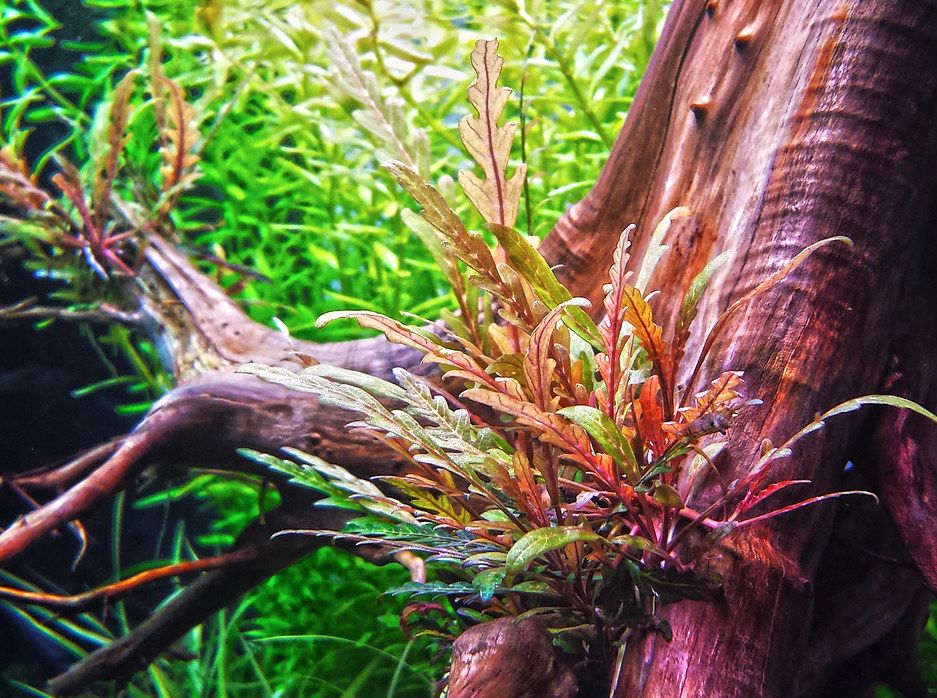
Contents
Plant Habitat in the wild
Hygrophila pinnatifida is native to the Southeast Asian region, specifically found in countries such as India, Bhutan, Nepal, and Bangladesh. This aquatic plant thrives in its natural habitats, which include streams, rivers, and marshes, particularly in the Western Ghats of India, where it flourishes at the bottom of tidelands.
In nature, Hygrophila pinnatifida is commonly found in shallow, slow-moving waters and can exist in both submerged and emergent forms. It tends to grow in areas with moderate to high water flow, often lining the banks of streams or partially submerged in flooded regions.
The plant prefers to anchor its roots in a substrate of nutrient-rich soil, sand, or gravel. This robust root system allows Hygrophila pinnatifida to maintain stability against water currents (like java moss), making it well-suited for its natural environment.
Characterized by a creeping or sprawling growth habit, Hygrophila pinnatifida produces stems that grow horizontally along the water surface or substrate, generating lateral shoots and forming dense patches of lush foliage. Its ability to spread and propagate laterally aids in its natural reproduction, contributing to its resilience and adaptability in various aquatic ecosystems.
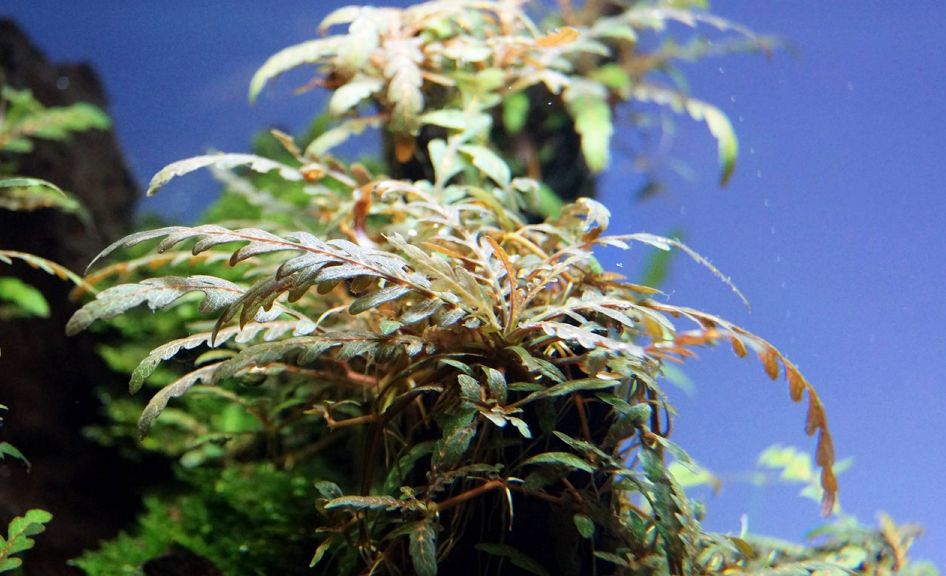
Description
Like ferns and anubias species, Hygrophila pinnatifida has the unique ability to anchor itself to stones and snags with its roots, which is relatively uncommon for long-stalked tank plants. The new shoots of this plant eagerly trail over the substrate, with each internode capable of striking roots into it, much like a ground-covering plant.
Once rooted, each vertical shoot develops an upright stem that may also incline towards the tank bottom, contributing to its intricate growth pattern. Typically, Hygrophila pinnatifida grows upright with creeping stems that spread horizontally, reaching a height of 15-40 cm (6-16 inches). Over time, it produces lateral shoots from the main stem, forming dense and lush foliage that creates a visually appealing effect in aquariums.
The plant features long, lanceolate leaves that can grow up to 15 cm (6 inches) in length. The coloration of the leaf’s upper surface can vary from dark green to brown, while the underside consistently displays a striking pink hue. The thick, solid stem of Hygrophila pinnatifida provides stability, allowing the plant to thrive in various water conditions.
Its pinnate leaves, adorned with multiple lobes or segments, increase the surface area for optimizing sunlight and carbon dioxide absorption. The lobes vary in size and shape, lending the plant an intricate and textured appearance. The relatively stiff leaves create a captivating contrast when paired with softer plant species in aquascapes. Additionally, the finely serrated or toothed edges of the leaves help reduce drag and minimize damage from water flow, enhancing its resilience in dynamic aquatic environments.
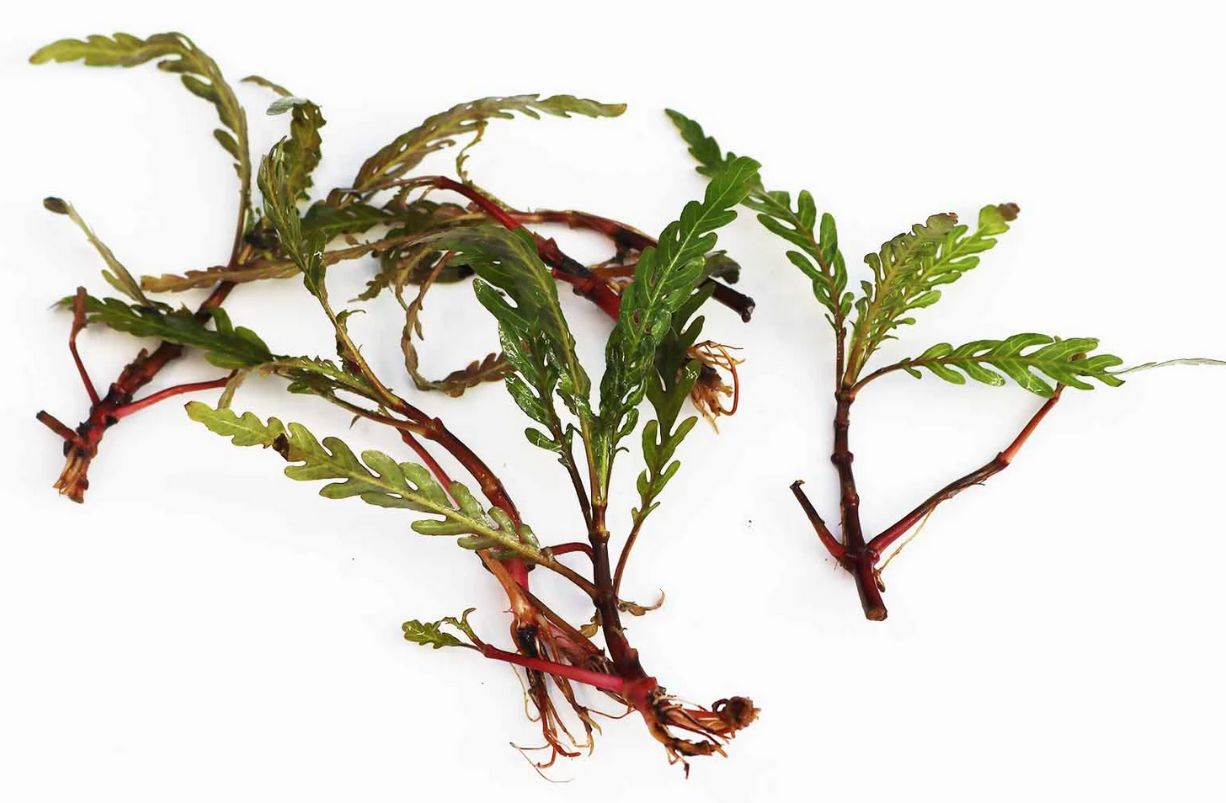
| Characteristic | Hygrophila pinnatifida |
|---|---|
| Common Name | Hygrophila pinnatifida; hygro pinnatifida |
| Origin | Southeast Asia |
| Growth Rate | Moderate to Fast |
| Height | 15-40 cm (6-16 inches) |
| Leaf Shape | Pinnate |
| Leaf Color | Green to Reddish-Brown |
| Lighting Requirements | Moderate to High |
| CO2 Requirements | Beneficial, but not essential |
| Water Temperature Range | 20-28°C (68-82°F) |
| pH Range | 6.0-7.5 |
| Hardiness | Moderate to High |
| Propagation | Cuttings, Lateral Shoots |
| Placement | Foreground, Midground, Background |
| Suitable for Beginners | No |
| Versatility | Suitable for Various Aquascaping Styles |
| Benefits | Adds Texture and Depth to Aquascapes |
| Challenges | Can Grow Tall and Require Frequent Trimming |
| Interaction with Fauna | Provides Shelter and Foraging Grounds |
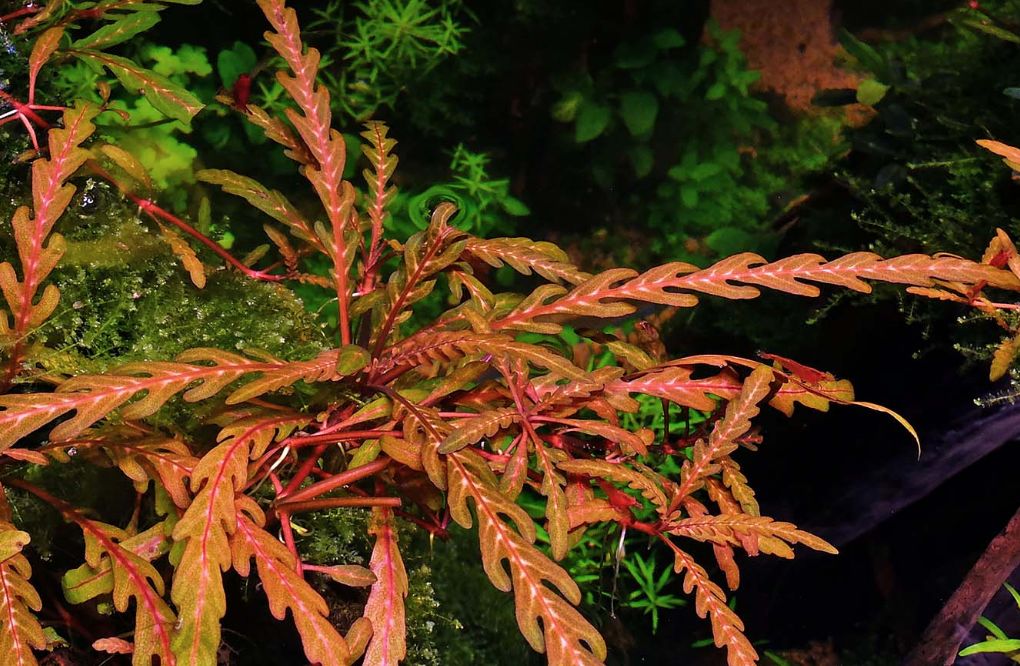
Difficulties in keeping
Hygrophila pinnatifida thrives under moderate light conditions, but when exposed to intense illumination, the plant tends to grow smaller. To encourage more compact growth, regular trimming of its shoots is recommended.
In addition to proper lighting, providing adequate nutrients in the tank water is essential for the healthy development of Hygrophila pinnatifida. This species is particularly sensitive to potassium deficiency, which manifests as small round holes appearing in the older leaves of the plant. To prevent this issue, aquarists should regularly test their water for nutrient levels and consider supplementing with potassium-rich fertilizers or CO2 to promote optimal growth.
Keeping in a tank
Hygrophila pinnatifida exhibits its best growth when provided with ideal tank conditions. Under optimal circumstances, the plant becomes bushy and develops a beautiful reddish hue, allowing aquarists to form attractive bushes through proper trimming. However, it can also thrive in amateur setups without CO2 supply or intense lighting.
In these less-than-ideal conditions, the plant often turns greenish and grows more vertically. Aquarists may notice small holes in the leaves, indicating a potassium deficiency in the tank water.
The growth rate of Hygrophila pinnatifida varies based on tank conditions and the stage of its growth. Under moderate lighting with limited nutrients and CO2, the plant tends to grow and reproduce slowly. Conversely, when exposed to intense lighting and provided with sufficient nutrients and CO2, its vertical shoots can reach the water surface quickly. In such cases, regular trimming is essential to maintain a manageable size and promote healthy growth.
In addition to these general care tips, here are some interesting facts about Hygrophila pinnatifida that can enhance your understanding of this remarkable plant:
- Color Variation: The reddish color that Hygrophila pinnatifida exhibits under ideal conditions is attributed to the presence of anthocyanins. These pigments not only give the leaves their vibrant hue but may also serve as a protective mechanism against excess light and UV radiation, which can be detrimental to plant health. This characteristic makes the plant particularly appealing in aquascapes, as it adds visual diversity.
- Trimming Benefits: Regular trimming of Hygrophila pinnatifida is beneficial for several reasons. It not only helps maintain the desired bushy appearance but also encourages the plant to produce new shoots, leading to denser growth. By cutting back taller stems, aquarists can promote lateral branching, enhancing the overall health of the plant. Additionally, regular pruning can prevent the plant from overshadowing smaller species in the aquarium, maintaining a balanced ecosystem.
- Amateur Care: While Hygrophila pinnatifida can survive in less-than-ideal conditions, optimal care can significantly enhance its beauty and health. For novice aquarists, providing the right lighting, nutrients, and water conditions can lead to rewarding results. This adaptability makes it an excellent choice for those looking to improve their aquarium’s aesthetics without the need for complex setups.
- Potassium Sources: Potassium is a vital nutrient for aquatic plants, playing a crucial role in various physiological processes, including photosynthesis and nutrient transport. To prevent deficiencies, aquarists can supplement potassium through various aquarium fertilizers, specifically those formulated for aquatic plants. Regular water testing can also help monitor nutrient levels, ensuring that the plant receives the necessary elements for optimal growth.
- Growth Indicators: A healthy Hygrophila pinnatifida should produce lush foliage and strong lateral growth. Signs of a thriving plant include vibrant coloration and bushy growth patterns. Conversely, stunted growth, discoloration, or leaf holes may indicate the need for adjustments in care, such as increasing nutrient availability or improving lighting conditions.
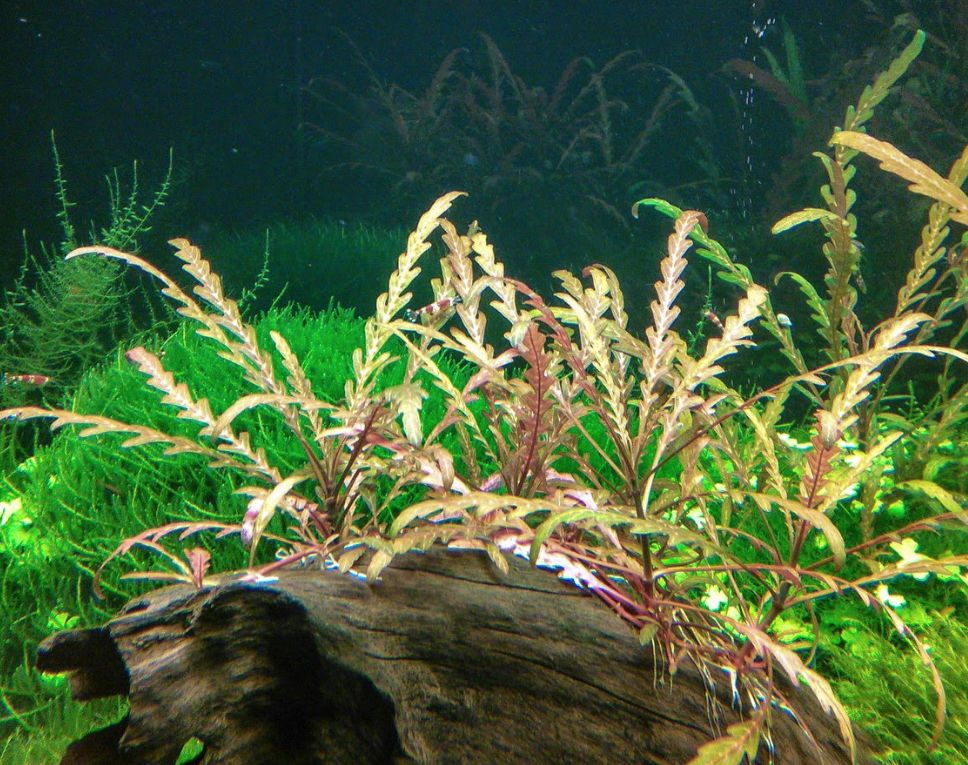
Lighting
Hygrophila pinnatifida thrives under moderate to high lighting conditions. To ensure optimal growth, it’s essential to have appropriate lighting fixtures, such as LED lights, that can provide sufficient light intensity. A general guideline is to aim for around 2-3 watts per gallon or to follow the manufacturer’s recommendations specific to the lighting system you are using. The intensity of light directly impacts the coloration of Hygrophila pinnatifida; under optimal conditions, the plant may exhibit vibrant reds and greens, while insufficient lighting can lead to a washed-out appearance.
Maintaining a consistent photoperiod of 8-10 hours per day is crucial. Providing this stable and appropriate amount of light each day helps create an ideal environment for Hygrophila pinnatifida, allowing it to flourish and maintain vibrant coloration. This photoperiod mimics natural conditions and allows the plant to photosynthesize effectively. Consistency in lighting is vital to prevent stress, which can lead to issues such as algae growth or poor plant health.
Interestingly, when Hygrophila pinnatifida is exposed to natural light conditions, it can begin to bloom, typically during the spring season. This blooming phenomenon can be a rewarding sight for aquarists, as it indicates the plant is thriving and adapting well to its environment. In an aquarium setting, replicating seasonal changes can lead to more vigorous growth and flowering.
While light is essential for plant growth, excess light can also lead to algae blooms, which compete with Hygrophila pinnatifida for nutrients and can diminish its beauty. Therefore, balancing light intensity and duration is key to preventing such issues and ensuring a healthy aquatic environment.
Water Parameters
Hygrophila pinnatifida is highly adaptable to a range of water parameters, making it a versatile choice for aquarists. It thrives at a water temperature between 20-28°C (68-82°F) and prefers a slightly acidic to slightly alkaline pH range of 6.0-7.5. While the plant can tolerate varying levels of water hardness, it generally prefers soft to moderately hard water.
CO2
While not mandatory, supplying supplemental CO2 can significantly enhance the growth and vibrancy of Hygrophila pinnatifida. The plant particularly benefits from CO2 injection in setups with higher light levels, where the increased availability of carbon dioxide can promote robust growth and more vibrant coloration.
For aquarists looking to optimize their aquarium conditions, considering a CO2 system can be a worthwhile investment. Maintaining optimal carbon dioxide levels not only aids in the photosynthesis process but also supports the overall health of the plant. Proper CO2 supplementation can lead to denser foliage, improved leaf structure, and a more lush appearance, making Hygrophila pinnatifida a stunning centerpiece in any aquascape.
Nutrients
Hygrophila pinnatifida thrives in nutrient-rich water, making regular supplementation essential for its optimal growth. Aquarists should regularly enrich their aquarium with vital nutrients, including macronutrients such as nitrogen, phosphorus, and potassium, as well as micronutrients like iron, magnesium, and trace elements.
Like all Hygrophila species, Hygrophila pinnatifida is particularly demanding when it comes to potassium content in the tank water. In most cases, an additional supply of potassium is necessary; without it, the plant’s older leaves may develop small round holes, indicating a deficiency.
Substrate
When it comes to substrate, the type is largely insignificant for Hygrophila pinnatifida, as it forms a relatively small and shallow root system. If you remove the plant from the substrate, you will notice that grains of substrate or sand tend to cling to its roots, indicating its minimal anchorage requirements.
If the plant is kept in a wet substrate with adequate light and fertilizers, you can cultivate its emersed form. In this state, the leaves will gradually become wider and shorter, taking on a greenish coloration, while the stems will grow upwards. This adaptation allows Hygrophila pinnatifida to thrive in varying conditions, providing aquarists with the opportunity to explore both submerged and emersed growth forms.
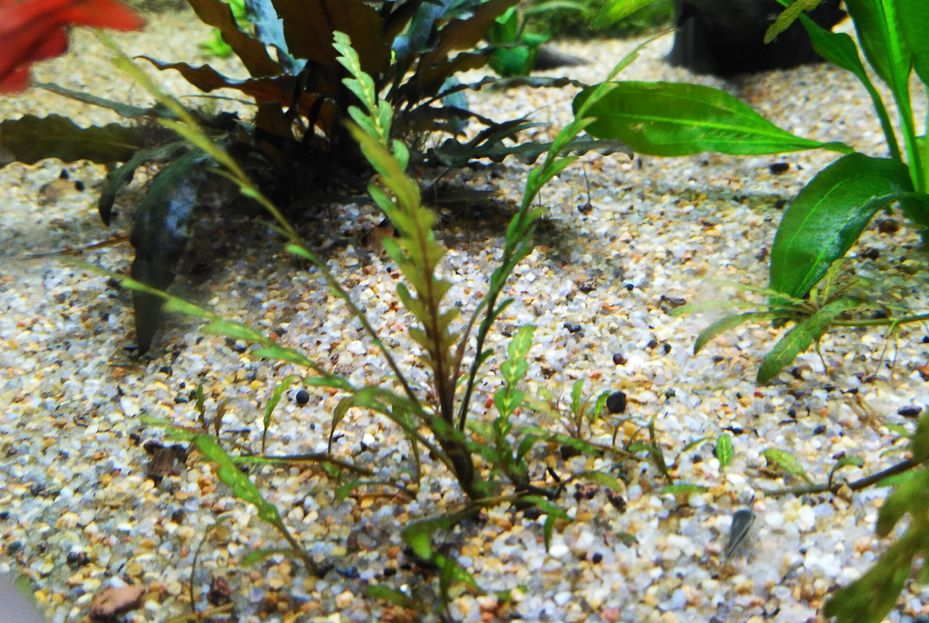
Planting
Hygrophila pinnatifida can be cultivated as an epiphyte, meaning it can be attached to surfaces such as rocks, driftwood, or other decorations in the aquarium. This method not only enhances the visual appeal of your aquascape but also creates a more natural-looking environment for the plant.
To grow Hygrophila pinnatifida on driftwood, take small portions of the plant and securely attach them to the driftwood. You can use cotton thread, fishing line, or plant-friendly adhesives like Super Glue to fasten the plant to the wood, ensuring that the roots make contact with the driftwood for optimal growth.
After securing the plant, place the driftwood in your desired location within the aquarium. Keep in mind the plant’s lighting requirements and the overall aquascape design. It is crucial to ensure that the attached Hygrophila pinnatifida has adequate access to light and water flow, which are essential for its growth and health.
Propagation
Hygrophila pinnatifida is primarily propagated through stem cuttings. When the plant is trimmed, it responds by actively forming numerous side branches at the cut points. Under favorable conditions, the plant can also produce horizontally growing shoots that easily strike roots, making propagation straightforward.